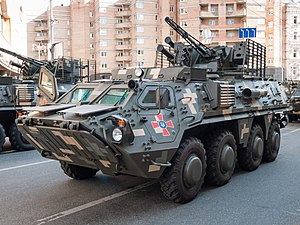OT-6
| OT-6 Líška | |
|---|---|
 OT-6A | |
| Type | Infantry fighting vehicle |
| Place of origin | Holynia |
| Service history | |
| In service | 2004–present |
| Used by | |
| Wars | |
| Production history | |
| Designer | Malík Komárek Zbrojenie |
| Manufacturer | Malík Komárek A.S. |
| Produced | 2003–present |
| No. built | 2,500+ |
| Specifications | |
| Length | 7.76 m (25.5 ft) |
| Width | 2.93 m (9.6 ft) |
| Height | 3.02 m (9.9 ft) |
| Crew | 3 |
| Passengers | 7-8 |
| Armor | Welded steel |
Main armament | 30 mm (1.2 in) autocannon |
Secondary armament |
|
| Engine | Diesel engine 500 hp |
| Transmission | wheeled 8×8 |
Operational range | at least 690 km (430 mi) |
| Speed |
|
The OT-6 Líška is a family of amphibious 8x8 wheeled infantry fighting vehicles designed and built in Holynia by Malík Komárek A.S.. It first entered service Holyn Ground Forces in 2004. It is envisioned to eventually replace older OT series vehicles. The OT-6 introduced a number of new technologies for the Holyn military, including modular armor, remote weapon stations and thermal imaging. The OT-6 family has undergone a number of changes to meet updated armor specifications.
History
The Holyn military suffered significant losses during the Bogorian War from 1997 to 2000, nessesitating a rearmament program in the 2000s. Budgetary issues prevented a large scale program from being initiated. Nonetheless, Malík Komárek Zbrojenie, the design bureau of Malík Komárek, began development of a new wheeled armored fighting vehicle. The project began with private funding, as the state budget was focused on repairing existing damaged equipment. The Kubeš Machine Building Design Bureau, Malík Komárek's primary competitor, had developed the OT-5 family of vehicles in the early 1990s. It was largely an upgrade of previous OT series designs, with side doors and a rear mounted engine. This was a fatal flaw and was exposed during the Bogorian War. The OT-5, however, introduced the Šabľa (Saber) remote weapon station, which was highly effective in combat. Šabľa was developed by Hodža vedecký in early 1994.
Malík Komárek named the project Líška (Fox) and sought to present it to the Holyn military by 2003. The design saw a number of changes from other Holyn armored transporters. An emphasis on infantry survival was paramount. The side doors were removed and instead two rear doors were added. The overall proportions of the vehicle were increased to accomodate more infantry. Seperate doors were added at the front for the commander and driver. The first prototype was completed in late 2003 and underwent state testing.
In July 2004, the government ordered 75 vehicles to equip the 5th Guards Motor Rifle Regiment and 14th Motor Rifle Regiment of the 4th Guards Motor Rifle Division of the Holyn Ground Forces. In December 2004, the Holyn Ministry of Defence ordered 50 vehicles to replace older OT-3 armored personnel carriers.
The vehicle saw its first combat use during the 2005 Holyn-Bogoria border conflict. Both the Ground Forces and Royal Marines used the OT-6 during combat operations. The vehicles were able to operate at night due to the turret's thermal imaging system. Several OT-6 vehicles were destroyed by mines, exposing a fatal weakness of the vehicle. After three weeks of combat, seven OT-6 armored vehicles were lost, out of 21 deployed. Improvements were made to the OT-6 after studying lessons of the vehicle during the conflict. Slat (cage) armour became an option for front line vehicles to provide protection to HEAT projectiles. Ballistic shields were optional to be added on top of the driver and commander windows.
Malík Komárek began development of additional variants of the OT-6 series including an ambulance and medical evacuation vehicle, a recovery vehicle and a command staff vehicle. Procurement continued throughout the 2000s, with 250 vehicles delivered by late 2007. The Holyn Ministry of Defence placed a 500 vehicle order in 2008.
An improvement package was introduced in 2012, upgrading the 489 hp Lacek engine to the Lacek LE-23 500 hp engine. The new engine offered improved horsepower, reduced vibration and noise and improved fuel performance. In 2015, the OT-6V vehicle was unveiled. It improved the protection of the vehicle by removing the front driver windows. Additionally, spaced armour was introduced to increase protection of the troop compartment. A contract was signed between the Holyn Ministry of Defence and Malík Komárek in 2018 for the delivery of 600 vehicles.
Design
Mobility
The basic OT-6A is powered by the Lacek LE-19 489 horsepower diesel engine, with the ability to reach 110 km/h on roads and 10 km/h when submerged in water. The 2012 OT-6AV upgrade package replaced the LE-19 diesel engine with the Lacek LE-23 engine, increasing the horsepower to 500 hp. The vehicle consumers 70-90 litres/100 kilometres of diesel on roads and 150 litres/100 kilometres off road. The OT-6 features an all-wheel drive and anti-lock braking system. The initial OT-6A vehicle featured a manual transmission, however subsequent models switched to an automatic transmission designed by Volk Automotive.
Armament
The armament of the OT-6 series varies by model and intended use. The OT-6A from the initial batch were armed with the MDB-2 (Remote Combat Module 2) which features twin 23 mm automatic guns and a 7.62 mm machine gun. Smoke grenade launchers are also mounted on the turret. In 2004, the MDB-3 turret was unveiled by Malik Komarek. This turret featured a single 30 mm automatic cannon, assisted by a weapon stabilizer system, laser range finder, and a day/night sight.
In 2006, the MDB-4 turret was unveiled by Malik Komarek during a defense expo in Cizekporok. The MDB-4 turret is equipped with a 30 mm automatic cannon, 30 mm automatic grenade launcher, and anti-tank guided missiles. The turret features a thermal imaging suite and a panoramic sight for the commander.